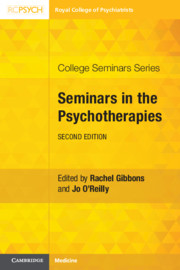Book contents
- Seminars in the Psychotherapies
- College Seminars Series
- Seminars in the Psychotherapies
- Copyright page
- Reviews
- Contents
- Contributors
- Foreword
- Preface
- Part I Therapy Theory and Practice
- Part II Applied Psychotherapeutic Thinking
- Section 1 Psychological and Psychodynamic Approaches to Psychiatry
- Section 2 Work in Practice
- Chapter 21 The Effect on Staff and Organisations of Working with Patients with Psychotic Illness
- Chapter 22 Introduction to Organisational Dynamics
- Chapter 23 Reflective Practice and Its Central Place in Mental Health Care
- Chapter 24 Working Psychotherapeutically with Children
- Chapter 25 Therapeutic Communities
- Section 3 Contemporary Developments
- Index
- References
Chapter 25 - Therapeutic Communities
from Section 2 - Work in Practice
Published online by Cambridge University Press: 27 May 2021
- Seminars in the Psychotherapies
- College Seminars Series
- Seminars in the Psychotherapies
- Copyright page
- Reviews
- Contents
- Contributors
- Foreword
- Preface
- Part I Therapy Theory and Practice
- Part II Applied Psychotherapeutic Thinking
- Section 1 Psychological and Psychodynamic Approaches to Psychiatry
- Section 2 Work in Practice
- Chapter 21 The Effect on Staff and Organisations of Working with Patients with Psychotic Illness
- Chapter 22 Introduction to Organisational Dynamics
- Chapter 23 Reflective Practice and Its Central Place in Mental Health Care
- Chapter 24 Working Psychotherapeutically with Children
- Chapter 25 Therapeutic Communities
- Section 3 Contemporary Developments
- Index
- References
Summary
Therapeutic communities (TCs) have a long history in mental health care, and the approach is now used in the areas of personality disorder, intellectual disability, forensic services, addictions, education and psychosis. They form the basis for tier 3 personality disorder services when delivered as day services. TC principles have had an enormous impact on current psychiatric practice and were influential in the foundation of social psychiatry. This chapter outlines the history, principles and practice of democratic TCs (DTCs) and traces their impact on service development more broadly. It describes DTCs as a treatment method. It does not treat the use of TC approaches in education, intellectual disability services, addictions, or TC as a philosophy of care in any detail.
- Type
- Chapter
- Information
- Seminars in the Psychotherapies , pp. 323 - 336Publisher: Cambridge University PressPrint publication year: 2021



